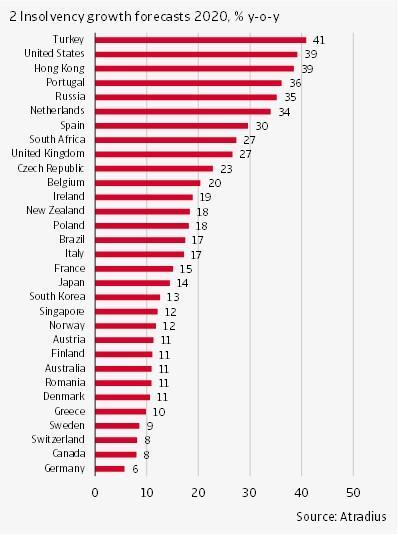Global corporate insolvencies are forecast to increase by 26% in 2020, led by Portugal, the Netherlands, Spain and UK in Europe
In response to global economic decline, every market is expected to experience a rise in insolvencies in 2020, led by Turkey with a 41% forecast increase, followed by the United States and Hong Kong with a forecast rise of 39%. Portugal, Russia, the Netherlands and Spain are the next worse affected regions with insolvencies up between 30% and 36%. A 27% increase is forecast for both South Africa and the UK, which has the ninth highest insolvency forecast out of 31 global markets.
Meanwhile, insolvencies are forecast to rise 19% in Ireland, 17% in Italy and 15% in France. Germany is expected to see the smallest increase at just 6% year on year.
This is according to the latest Atradius Insolvency Report, which analyses the economic impact of the COVID-19 pandemic and the knock-on effect on insolvencies. Every major economy, except for China, is expected to enter recession this year with global GDP forecast to contract by 4.5%, making this recession more acute in magnitude than the Great Recession of 2009.
The UK is expected to see the largest GDP contraction in Northern Europe following a stringent lockdown and high Brexit uncertainty. Atradius economists report that the depth and length of the global recession will be determined by the ability of economies to manage health regulations and either achieve exit from lockdown or find a way to thrive with social distancing.

Atradius economists highlight that Southern European economies such as Spain, Italy, France, Portugal and Greece are experiencing a larger coronavirus impact than Northern Europe as they typically rely more heavily on tourism. By comparison, Germany, Denmark, Austria and the Netherlands are less dependent on tourism and have fared better in containing new infections, with their economies seeming to adapt better to social distancing regulations.
Across the countries reported on, there is a wide range of insolvency projections, depending on the severity of the economic contraction and the insolvency elasticity – the percent responsiveness of insolvencies to one percent GDP change.
Atradius Chief Economist John Lorié commented: “Government measures have reduced the anticipated increase in bankruptcy filings in a range of ways. They have either shifted the threshold for filing, reduced debtor’s ability to force bankruptcy, or provided sufficient financial support to delay filings. However as the support programs begin to expire, the number of filings should climb rapidly.”
Looking forward, Atradius’ Insolvency Report forecasts Spain to see the greatest rise in bankruptcies in 2021 at 26% year on year, followed by Australia at 22% and France at 5%. Finland, Norway, the Netherlands, Canada, Switzerland and Sweden are also forecast to see a small rise in insolvencies of between 2% to 4% with most regions expected to see a fall. The UK’s insolvency rate is forecast to drop by 1% in 2021. However, this is still a cumulative growth of 25% between 2019 and 2021.
Simon Rockett, senior underwriting manager for Atradius UK, commented: “The coronavirus pandemic has been indiscriminate in its spread across the globe, resulting in lockdowns and containment measures which have had a tangible impact on economic markets. This has included delays in production, a drop in business and consumer demand and widespread business closures. While many countries have implemented fiscal stimulus measures to soften the blow, these cannot last forever and worldwide economies are starting to realise the true economic impact in the form of recession and a bleak return to rising insolvency levels.”
“Real-time monitoring of global markets and the impact on individual businesses, together with agility in response are critical factors in navigating today’s uncertain climate. The continuation of trade is essential to rebuilding business growth while a robust risk strategy to protect the bottom line is as important today as it has ever been”




















No comments yet